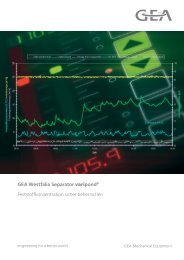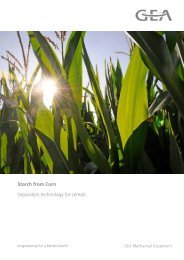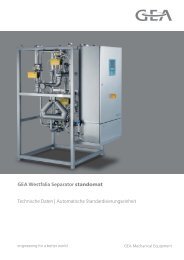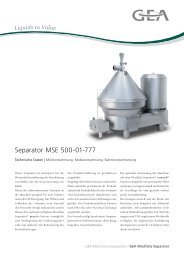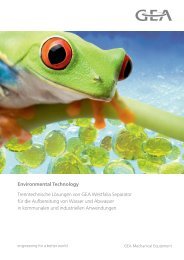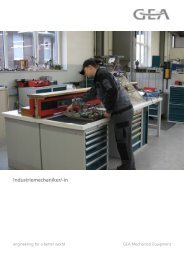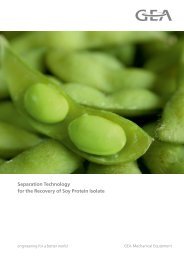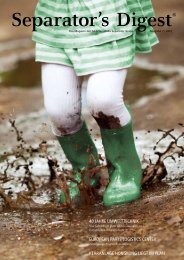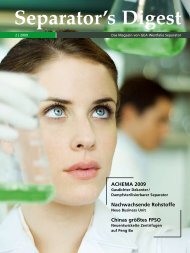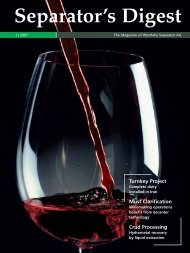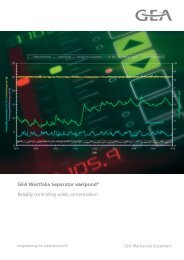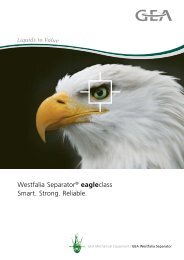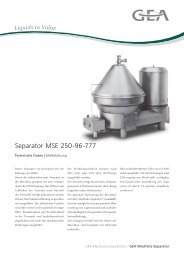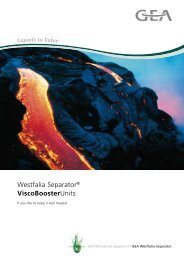Separator's Digest 2008/1 - GEA Westfalia Separator Group
Separator's Digest 2008/1 - GEA Westfalia Separator Group
Separator's Digest 2008/1 - GEA Westfalia Separator Group
You also want an ePaper? Increase the reach of your titles
YUMPU automatically turns print PDFs into web optimized ePapers that Google loves.
<strong>Separator</strong>’s <strong>Digest</strong><br />
1 | <strong>2008</strong><br />
Mega Waste Water<br />
Treatment Plant Completed<br />
Changi is running<br />
Boost Gas Yield – Optimise<br />
Sewage Sludge Treatment<br />
<strong>Westfalia</strong> <strong>Separator</strong> biogasplus<br />
Sustainability<br />
Thanks to Biofuels<br />
Treatment with compact units<br />
The Magazine of <strong>Westfalia</strong> <strong>Separator</strong>
Contents<br />
3 PREFACE<br />
3 “Green“ Centrifuges<br />
4 SEPARATOR´S NEWS<br />
4 Topical<br />
8<br />
Imprint<br />
The information contained in this brochure merely serves as a<br />
non-binding description of our products and is without guarantee.<br />
Binding information, in particular relating to capacity data and<br />
suitability for specific applications, can only be provided within the<br />
framework of concrete inquiries.<br />
FOOD TEC<br />
8 Biofuel Second Generation<br />
10 Greek Yoghurt Also Suits the American Taste<br />
12 INDUSTRY<br />
12 New Bioethanol Decanter<br />
14<br />
34 LIFESTYLE<br />
34 The Truth is on the Pitch<br />
Publisher:<br />
<strong>Westfalia</strong> <strong>Separator</strong> GmbH<br />
Project management:<br />
Peter Arens<br />
Editors:<br />
Peter Arens (Person responsible<br />
according to the German Press Law),<br />
Dr. Jörg Bückle, Manfred Kaiser<br />
MINERALOIL SYSTEMS<br />
14 Waste Oil is More Than Merely Waste<br />
16 Sustainability Thanks to Biofuels<br />
18 Combined Heat and Power<br />
in the Swimming Pool Tongelreep<br />
21<br />
UMWELTTECHNIK<br />
21 More Gas, Less Sludge<br />
24 Outstanding<br />
26 MBR Decanter as<br />
Forward-Looking Technology<br />
30 Changi is Running<br />
32 Environmentally-Friendly<br />
Liquid Manure Processing in Belgium<br />
Photography:<br />
Michael Dannenmann, Tim Luhmann,<br />
Archive <strong>Westfalia</strong> <strong>Separator</strong> GmbH<br />
Conception and Layout:<br />
Kabutz Communication GmbH<br />
Feldstraße 5 · 59423 Unna<br />
info@kabutz.de · www.kabutz.de
“Green”<br />
Centrifuges<br />
THE RAPID AND UNSTOPPABLE GROWTH IN THE GLOBAL<br />
POPULATION IS ONE OF THE MAJOR CHALLENGES OF<br />
OUR TIMES: AS RECENTLY AS 100 YEARS AGO, THE<br />
POPULATION OF OUR PLANET WAS ONLY 1.6 BILLION<br />
PEOPLE.<br />
Today, in the year <strong>2008</strong>, more than<br />
6.5 billion people live on our planet.<br />
Around the year 2050, in other words in<br />
somewhat more than one generation, more<br />
than 9 billion people will have to share the<br />
same space. The global population has<br />
therefore increased five-fold in a period of<br />
150 years, which is negligible in terms of<br />
the history of the world. There will be<br />
a shortage of space on the earth. People<br />
will have to live more closely together.<br />
Water supply in particular will become<br />
an urgent problem facing humanity.<br />
The United Nations have therefore<br />
designated the years 2005 to 2015<br />
as the international decade of “Water<br />
for Life”. The aims include a considerable<br />
improvement in access to drinking water<br />
and an improvement in the effluent<br />
situation. Nevertheless, around 90 percent<br />
of all domestic effluent and 70 percent<br />
of industrial effluent in developing<br />
countries is discharged untreated into<br />
the water cycle endangering reserves of<br />
drinking water.<br />
At <strong>Westfalia</strong> <strong>Separator</strong>, environmental<br />
protection is anything but a temporary fad.<br />
Waste water clarification and fresh water<br />
processing are challenges which have been<br />
faced by <strong>GEA</strong> <strong>Westfalia</strong> <strong>Separator</strong> for many<br />
decades and in which the company has<br />
built up sound know-how. Mechanical<br />
separation technology has the advantage<br />
over other technologies by providing a<br />
simple attractive solution to the problem of<br />
providing clean water for an expanding<br />
global population. It functions purely by<br />
physical means and without any chemical<br />
additives. It can be cleaned easily and<br />
is stable in terms of temperature while<br />
its continuous operation permits high<br />
throughput capacities.<br />
Under the concept <strong>Westfalia</strong> <strong>Separator</strong><br />
seaprotectsolutions we also offer a new<br />
generation of separators which reliably<br />
process bilgewater and sludges containing<br />
oil, offering a high degree of reliability<br />
when travelling in sensitive areas of<br />
the world’s oceans. In the standard<br />
version, these centrifuges achieve effluent<br />
qualities of < 10 ppm. With the support of<br />
additional units, they are able to achieve<br />
effluent qualities of < 5 ppm. In this way,<br />
pure water can be discharged into the<br />
oceans and our environment can be<br />
protected.<br />
Preface<br />
3<br />
<strong>Separator</strong>’s <strong>Digest</strong> 1 | <strong>2008</strong><br />
Preface<br />
We are again demonstrating our skills in<br />
environmental protection at IFAT <strong>2008</strong>.<br />
This is the most important environmental<br />
exhibition in the world focusing on water,<br />
effluent, waste disposal and recycling and is<br />
due to be held in Munich between 5 and<br />
9 May <strong>2008</strong>. At the exhibition, our<br />
machines, which are green both in<br />
colour and in their operation and are<br />
known as “the green machines”, will<br />
be demonstrating their contribution to<br />
environmental protection issues. Let us take<br />
advantage of this opportunity.<br />
Holger Heinrich<br />
Division President
<strong>Separator</strong>‘s News<br />
In <strong>2008</strong>, the most important environmental<br />
exhibition in the world will be even<br />
larger than three years ago, with an<br />
exhibition area totalling 192,000 m 2 . This is<br />
equivalent to growth of 13 percent. With<br />
2223 exhibitors from 36 countries as<br />
well as 109,000 trade visitors from<br />
166 countries, the event already presented<br />
record figures back in 2005.<br />
New Munich<br />
Trade Fair Centre<br />
5 – 9 May<br />
IFAT <strong>2008</strong> with Record Figures<br />
At IFAT, the 15th International Trade Fair for<br />
Water, Effluent, Waste and Recycling,<br />
which is due to be held in Munich between<br />
5 and 9 May <strong>2008</strong>, visitors to the<br />
exhibition will see innovative, practical and<br />
cost-effective sector and state-of-the-art<br />
solutions as well as a wide range of<br />
associated services. The expansion of the<br />
subject of recovering energy from waste<br />
materials will result in more attention<br />
being devoted to the field of biogas. The<br />
exhibition will therefore focus on current<br />
developments in the market and will again<br />
demonstrate its pioneering role as a leading<br />
international forum.<br />
<strong>Westfalia</strong>
<strong>Separator</strong> Goes China<br />
As a company with global operations, it is becoming<br />
increasingly important for <strong>Westfalia</strong> <strong>Separator</strong> to produce<br />
products on the world market and show a physical<br />
presence in the large emerging markets. <strong>Westfalia</strong><br />
<strong>Separator</strong> has now officially commissioned a plant in China<br />
to open in the spring of <strong>2008</strong>. With the establishment of<br />
<strong>Westfalia</strong> <strong>Separator</strong> (Tianjin) Co., Ltd., <strong>Westfalia</strong> <strong>Separator</strong><br />
has now established a direct presence with its own<br />
subsidiary in this booming country. The opening of the<br />
new plant will achieve two objectives. The reduction of the<br />
length of service routes to the company’s growing<br />
number of Chinese customers and the local production of<br />
separators and spare parts to bring costs in line with<br />
general market levels.<br />
The operating facility in the Innovation Incubator Park<br />
in Tianjin in Tanggu district covers an area of more<br />
than 5500 m 2 , housing production facilities as well as<br />
<strong>Separator</strong>’s News 5<br />
administration offices. The plant is equipped with a<br />
modern machine park for repairing centrifuges and<br />
decanters and also for manufacturing pre-assembled<br />
compact units for marine applications.<br />
Smooth delivery of spare parts<br />
and rapid technical support<br />
<strong>Westfalia</strong> <strong>Separator</strong> (Tianjin) Co., Ltd. has been designed<br />
primarily to provide Chinese customers with high quality<br />
products, rapid technical service and smooth delivery of<br />
original spare parts in line with the world-wide standard at<br />
<strong>GEA</strong> <strong>Westfalia</strong> <strong>Separator</strong>.<br />
<strong>Separator</strong>’s <strong>Digest</strong> 1 | <strong>2008</strong><br />
<strong>Separator</strong>‘s News<br />
Argentina:<br />
Quality<br />
Improvement in Service<br />
<strong>Westfalia</strong> <strong>Separator</strong> Argentina has also satisfied the criteria applicable for an<br />
authorized workshop. “The authorized workshop is the best reflection of<br />
our success”, Sergio Bloch proudly states, Managing Director of <strong>Westfalia</strong><br />
<strong>Separator</strong> Argentina. As an authorized workshop, <strong>Westfalia</strong> <strong>Separator</strong><br />
Argentina is better able to meet the requirements of customers, to<br />
optimise the services and also to guarantee confidence in the<br />
machines and processes of <strong>Westfalia</strong> <strong>Separator</strong>. The Safety<br />
Officer of <strong>Westfalia</strong> <strong>Separator</strong> Argentina is Maximiliano<br />
Zylbersztajn.
<strong>Separator</strong>‘s News<br />
<strong>Westfalia</strong> <strong>Separator</strong> Mineraloil Systems moved into its new<br />
premises in Hamburg-Harburg in the middle of last year.<br />
The authorized workshop was opened in the autumn of<br />
2007. All service products of the “Original Manufacturer<br />
Service” (OMS), including spare parts, sales, repairs,<br />
technical customer service, training and process<br />
optimisation, are now united for the first time under one<br />
roof at the new location.<br />
For professional handling of spare parts logistics, the<br />
company has engaged the services of an external service<br />
provider who is now responsible for handling all aspects of<br />
warehouse organisation. The new repair workshop, with<br />
its own balancing and testing room, is located over an<br />
area of approx. 600 m 2 between the warehouse and the<br />
office building.<br />
6<br />
<strong>Separator</strong>’s <strong>Digest</strong> 1 | <strong>2008</strong><br />
New infrastructure for training<br />
An appropriate infrastructure has been created to provide<br />
training for customers, employees of subsidiaries and<br />
internal employees. A separate training room is available<br />
which is equipped with simulation equipment. This means<br />
that tests can be carried out on machines under conditions<br />
which are as realistic as possible. The workshop has a test<br />
bay which can also be used for training purposes. The new<br />
service product “Process Improvement” is also integrated<br />
in the Hamburg organisation.<br />
<strong>Separator</strong>’s News<br />
All Service<br />
Products<br />
Under One<br />
Roof<br />
at New<br />
Location in<br />
Hamburg<br />
Hamburg-Harburg is the name<br />
of the new location of the<br />
branch of <strong>Westfalia</strong> <strong>Separator</strong><br />
Mineraloil Systems – close to<br />
the port of Hamburg and close<br />
to the customers.
First Double Cream Cheese<br />
Installation for Russia<br />
Butter and processed cheese from the house of Karat are familiar to<br />
anybody who has used Aeroflot to travel to Russia. Karat<br />
owns three dairies in Russia, and has been known primarily as a<br />
manufacturer of processed cheese specialities since 1934. In<br />
Moscow, the company has now invested in an installation for<br />
making double cream cheese. Within the framework of this order,<br />
the Business Unit Dairy Technology supplied one KSA machine for<br />
making double cream cheese, one CSE machine for bacteria removal<br />
from the milk for making double cream cheese as well as one<br />
CNE bacteria-removing machine for the operating room. The milk<br />
for making double cream cheese is first passed through the<br />
fat-standardising phase before it enters a pasteurising unit supplied<br />
by <strong>Westfalia</strong> <strong>Separator</strong>; this unit, with an hourly capacity of<br />
<strong>Separator</strong>’s News<br />
7<br />
<strong>Separator</strong>’s <strong>Digest</strong> 1 | <strong>2008</strong><br />
<strong>Separator</strong>‘s News<br />
5000 litres, is where bacteria are removed, and the product is<br />
degassed, homogenised and pasteurised. The milk is then coagulated<br />
in special tanks, and heated to a separation temperature of approx.<br />
80 °C. The process of concentrating the coagulated milk in the<br />
KSA separator achieves a double cream cheese with on average<br />
70 percent fat in the dry matter. Maximum product variety is<br />
ensured by means of inline salt addition as well as facilities for<br />
mixing in further ingredients and subsequently blanketing the product<br />
with nitrogen. The scope of supply also includes a CIP system for<br />
cleaning the production equipment. Depending on the particular<br />
recipe used, up to ten tons of double cream cheese can be made<br />
every day. From <strong>2008</strong>, the double cream cheese on your tray on a<br />
flight to Russia might be made by machines from <strong>Westfalia</strong> <strong>Separator</strong>.<br />
Safety Receives Maximum Priority in India<br />
Without doubt, safety receives maximum priority at <strong>Westfalia</strong><br />
<strong>Separator</strong> India; not only does service and repair work have to be<br />
carried out in accordance with the safety specifications of <strong>Westfalia</strong><br />
<strong>Separator</strong>, it is necessary to cope with a wide range of assembly and<br />
production tasks. Since mid-2007, <strong>Westfalia</strong> <strong>Separator</strong> India has<br />
also had an authorized workshop in Bengaluru. Raman Mehta has<br />
been trained as the Safety Officer. Managing Director Ashok Narula<br />
explained that the authorized workshop can undertake numerous<br />
tasks. In addition to a small-scale assembly facility and as a<br />
<strong>Westfalia</strong> <strong>Separator</strong> centripack workshop, the range of services has<br />
now also been extended. Repair work is carried out and customer<br />
training is provided to allow even greater access to the market. The<br />
authorized workshop of Bengaluru is now also certified by the<br />
TÜV in accordance with ISO 9001, and the products meet CE<br />
specifications.
Food Tec<br />
As a diesel substitute, this biofuel also has<br />
local customers among local freight carriers, in<br />
agriculture and at some fuel stations. <strong>Westfalia</strong><br />
<strong>Separator</strong> has skilfully combined centrifugal<br />
technology and membrane technology for<br />
the necessary purification of the pressed oil. The<br />
product recovered from this process is of<br />
extremely high quality and, in certain cases, far<br />
exceeds the limits specified in the preliminary<br />
standard which enable the product to be<br />
exempted from mineral oil tax. In addition, by<br />
way of comparison with flotation filtration, the<br />
oil enjoys a considerable advantage in terms of<br />
cost.<br />
T<br />
Biofuel<br />
Second Generation<br />
HYBRID SOLUTION COMBINING CENTRIFUGAL<br />
TECHNOLOGY AND MEMBRANE FILTER TECHNOLOGY<br />
FOR LOCAL COLD PRESSING OF RAPESEED OIL<br />
“From the region for the region” is the aim of operators of local oil mills<br />
in Germany. With cold pressing of oil seeds, mainly rapeseed, these oil mills<br />
primarily recover rapeseed oil fuel with processing capacities of between<br />
0.5 and 25 tons per day.<br />
“Green” energy<br />
Far more than 200 local oil seed processing<br />
installations have been constructed in Germany<br />
since the beginning of the 1990s. They produce<br />
mainly rapeseed oil fuel by means of a coldpressing<br />
technique; however, they also produce<br />
rapeseed cooking oil, which is becoming more<br />
and more popular among the population, animal<br />
feed oil and man-made oils; the latter are used as<br />
a raw material for transesterification in biodiesel<br />
production. The related demand is enormous.<br />
Rapeseed is attractive as a substitute for diesel<br />
fuel in various ways. Mineral oil tax is currently<br />
levied on diesel fuel at a rate of 47.06 cents/l; by<br />
way of comparison, the tax imposed on rapeseed<br />
fuel is currently running at 10 cents/l. This means<br />
that the price of rapeseed oil at the pump is<br />
around 1 euro per litre, which is approximately<br />
25 percent lower than the price of diesel, but<br />
with a comparable energy-producing value.<br />
Numerous oil mill operators use the biofuel<br />
which is recovered directly within their own<br />
agricultural operations for tractors and cars or for<br />
vegetable oil combined heat and power units.
Elegant hybrid solution<br />
The rapeseed is pressed mainly in filter cage<br />
bar scroll-type presses. The pressed trub oil<br />
has to be purified further. For this purpose,<br />
flotation filters or chamber filter presses are<br />
frequently used for preliminary filtration,<br />
with a subsequent two-stage safety and<br />
polishing filtration process using cartridge<br />
filters. However, this filtration technology is<br />
relatively labour-intensive, and the filter<br />
aids also have a high replacement cost.<br />
<strong>Westfalia</strong> <strong>Separator</strong> has adopted a more<br />
elegant solution. The acquisition two years<br />
ago of Membraflow, which specialises in<br />
ceramic membrane filter technology, has<br />
enabled <strong>Westfalia</strong> <strong>Separator</strong> not only to<br />
connect the know-how from centrifugal<br />
technology with membrane technology in<br />
series; it has also enabled the company to<br />
skilfully combine the two techniques.<br />
Normally, the pressed trub oil is sent to the<br />
decanter centrifuge which removes the<br />
coarse dirt. The pre-treated oil is then sent<br />
to a membrane filtration unit which filters<br />
out the extremely fine trub particles and<br />
concentrates the solids in the concentrate<br />
circuit. The approach of <strong>Westfalia</strong> <strong>Separator</strong><br />
now goes one step further: the filter<br />
concentrate is again continuously recycled<br />
back into the decanter centrifuge and<br />
added to the raw oil. As the membrane<br />
installation increases the solids concentration,<br />
it also becomes more likely that the solids<br />
will be agglomerated. It thus again<br />
becomes “tangible” for the decanter and<br />
its consistency means that it can be<br />
discharged. These solids can be added to<br />
the press cake in order to be recycled as<br />
animal feed. With this hybrid solution, the<br />
decanter is able to remove trub particles<br />
which it is not able to remove in the first<br />
process.<br />
Food Tec<br />
Permanent operation<br />
This closed system achieves continuous and<br />
fully automatic 24 h permanent operation<br />
of up to six months without the membrane<br />
unit having to be cleaned. This is a crucial<br />
advantage, because, with chamber filter<br />
presses, the cycle times are comparatively<br />
low, namely 6 to 24 hours. Depending on<br />
the size of the decanter/ceramic membrane<br />
hybrid unit, this results in annual cost<br />
savings of up to 100,000 euros.<br />
For these benefits to be achieved, it is<br />
of course essential that the quality of<br />
the recovered rapeseed oil is right and<br />
complies with the preliminary standard of<br />
V DIN 51605. The investigated parameters<br />
demonstrate: the hybrid solution presented<br />
by <strong>Westfalia</strong> <strong>Separator</strong> for local cold<br />
pressing of rapeseed provides a top-quality<br />
product.
Greek<br />
Yoghurt Also Suits the<br />
MARKET LEADER FOR CREAM CHEESE SEPARATION<br />
<strong>Westfalia</strong> <strong>Separator</strong> is the market leader in the<br />
field of centrifugal separation of cream cheese. It<br />
supplies stand-alone machines right through to a<br />
complete production line, starting with the<br />
pasteurising unit, the fermentation equipment,<br />
the heat treatment unit, the various mixing<br />
systems for cream, stabilisers, sugar, aromas,<br />
fruit, herbs, nitrogen, etc. This also includes the<br />
CIP cleaning system for the separator or the<br />
complete line.<br />
The FAGE dairy in Greece ordered six machines<br />
last year alone. The first four separators were<br />
installed in the company’s main plant in Athens.<br />
A completely new plant is being built in the USA,<br />
and two further machines and equipment have<br />
been earmarked for this new plant.<br />
Largest dairy operation in Greece<br />
with the latest technology<br />
According to FAGE S.A., it is the largest dairy<br />
operation in Greece, with a history which goes<br />
back 80 years. In 1975, this company launched<br />
the first commercial brand of yoghurt in Greece.<br />
A new trend then started on the Greek yoghurt<br />
market. FAGE is one of the most modern dairy<br />
operations in Europe. With the latest technology,<br />
FAGE is able to process 50,000 litres of milk every<br />
hour and to produce 500,000 tubs of yoghurt<br />
every year. FAGE USA Corp., a subsidiary of FAGE<br />
S.A., was established in the state of New York in<br />
June 2000. The US sales subsidiary is to market<br />
the quality products on a nationwide basis to US<br />
consumers. In future, the new FAGE dairy in the<br />
state of New York will produce the Greek yoghurt<br />
and further products for the US market.<br />
Complete production<br />
line modernised<br />
As a result of more stringent product guidelines,<br />
particularly regarding the shelf-life and a<br />
maximum degree of automation, FAGE has<br />
modernised the complete production line in<br />
Greece. Following extensive tests with a KDB 30<br />
which had previously been made available, the<br />
existing separators of the competition were<br />
replaced. Each of the KDB 30 machines was<br />
installed with a separate valve block and DCA 20<br />
cleaning unit. This ensures that FAGE is able to<br />
produce flexibly with its eight fermentation<br />
tanks, each of which has a capacity of<br />
50,000 litres. In these tanks, special yoghurt<br />
cultures are used to add acid to and curdle the<br />
pasteurised skimmed milk. The fermentation<br />
process of the yoghurt takes between five and six<br />
hours at a temperature of 40 °C. The whey is<br />
then separated in the KDB 30 separators.<br />
10<br />
<strong>Separator</strong>’s <strong>Digest</strong> 1 | <strong>2008</strong><br />
Food Tec
American Taste<br />
Installation in a<br />
very limited space<br />
FAGE is extremely satisfied with the excellent<br />
consistency and shelf-life of the product which is<br />
achieved with this process. The equipment had to<br />
be installed in a very limited space. In addition,<br />
it was also necessary for the equipment to be<br />
designed in accordance with the specifications of<br />
the FDA (Food and Drug Administration) and<br />
NYSDAM (New York State Department of<br />
Agriculture and Markets) the 3 A Standard,<br />
PMO (Pasteurized Milk Ordinance) and the GMP<br />
stipulations.<br />
CROSS-BORDER PROJECT REALISATION<br />
Food Tec 11<br />
<strong>Separator</strong>’s <strong>Digest</strong> 1 | <strong>2008</strong><br />
<strong>Westfalia</strong> <strong>Separator</strong> Hellas and <strong>Westfalia</strong><br />
<strong>Separator</strong> Food Tec, as well as<br />
<strong>Westfalia</strong> <strong>Separator</strong> Engineering and<br />
<strong>Westfalia</strong> <strong>Separator</strong> Inc. USA, worked closely<br />
together in the realisation of the project.<br />
As a result of the flexible preassembly in<br />
Oelde and an extremely motivated assembly<br />
team in Athens, the separators were delivered<br />
on time despite special requirements and full<br />
capacity utilisation. Now Greek yoghurt can<br />
suit the American as well as the Greek taste.
Industry<br />
New Bioethanol D<br />
DG 300: SPECIAL DESIGN FOR SAFE HOT OPERATION
ecanter<br />
Demand has demonstrated that the<br />
concept is convincing: the first three<br />
machines of this new type were delivered<br />
to a customer in Slovakia shortly after<br />
the initial market launch in 2006. From<br />
2007, more than 40 further machines were<br />
sold to various customers for a wide range<br />
of applications.<br />
Five DG 300 decanters<br />
for an installation in the<br />
Benelux countries<br />
One of these users is a leading bioethanol<br />
company in the Benelux countries. The<br />
manufacturer is currently in the process of<br />
building a new bioethanol factory with a<br />
capacity of 150,000 m 3 bioethanol per<br />
annum in order to process the wheat and<br />
sugar by-products. The plant is scheduled<br />
to go on stream in <strong>2008</strong>. For this purpose,<br />
the customer has commissioned <strong>Westfalia</strong><br />
<strong>Separator</strong> to deliver five DG 300 decanters.<br />
The new decanters were an attractive<br />
option because of their high capacity, their<br />
technical features (such as hybrid design<br />
and scroll-type structure) and the very low<br />
noise emissions: with an operating speed<br />
of 3500 rpm, the noise emission is approx.<br />
80 dB(A). The decanters are used for<br />
thickening the distillation sump. The<br />
decanter solids are then forwarded to a<br />
dryer for animal feed production.<br />
New type of scroll<br />
design <strong>Westfalia</strong> <strong>Separator</strong><br />
centricflow<br />
The DG 300 is the successor model for the<br />
CB 505, which has been very successful in<br />
practice. One of the main improvements<br />
is the design of the <strong>Westfalia</strong> <strong>Separator</strong><br />
centricflow scroll. This scroll, which<br />
has been designed specifically for the<br />
bioethanol application, achieves a lowturbulence<br />
flow in the bowl, enabling the<br />
solids to sediment much more easily.<br />
Further special features of the new<br />
bioethanol decanter include the simplified<br />
drive design (which utilizes a differential<br />
gear) as well as the discharge of the<br />
clarified phase under gravity. The DG 300<br />
discharges the product streams with a<br />
small diameter, which means that it is very<br />
energy-efficient to operate.<br />
High-quality processing for<br />
hot application<br />
Temperatures of up to 95 °C are by no<br />
means rare when the distillation sump is<br />
thickened as part of the production of<br />
bioethanol. High-quality processing is<br />
therefore very important. This is the reason<br />
why <strong>Westfalia</strong> <strong>Separator</strong> has designed a<br />
completely new type of housing using<br />
hybrid technology. The new hybrid frame<br />
consists of carbon steel (externally) and<br />
stainless steel (internally). Together with<br />
the scroll and bowl, this means that the<br />
DG 300 is extremely resistant to corrosion.<br />
If any deposits and impurities become<br />
lodged between the bowl and the<br />
housing, they can easily be removed<br />
with the integrated spray nozzles; this<br />
means that the decanter does not<br />
have to be opened specially for this<br />
purpose. All seals in the new bioethanol<br />
decanter are of course designed for hot<br />
operations; this permits safe production<br />
and also long CIP cleaning runs at high<br />
temperatures.<br />
Industry 13<br />
<strong>Separator</strong>’s <strong>Digest</strong> 1 | <strong>2008</strong><br />
Industry<br />
The DG 300 decanter with a hybrid design is the new development in the high-speed “5”<br />
class. It has been built and designed for applications in industrial biotechnology, the<br />
chemical industry, starch technology and the food industry.<br />
Cooling for the bearings<br />
A further major advantage of the DG 300,<br />
and also a unique feature in its class, are the<br />
oil-lubricated bowl bearings. The gear and<br />
the bowl bearing are equipped with an<br />
automatic oil-circulation lubrication facility.<br />
The oil itself is also cooled and filtered; this<br />
helps to ensure a longer service life for<br />
the bearings. In this way, the decanter<br />
operation is not affected by the high<br />
product temperatures; the bowl speed does<br />
not have to be reduced, and the decanter<br />
can develop its full power.<br />
1000 m 3 g-volume<br />
over 4 m 2<br />
In conjunction with the deep pond, the<br />
g-force of 3850 g is responsible for the<br />
high performance and the exceptional<br />
dewatering figures of the decanter. In this<br />
way, even extremely fine particles are<br />
reliably separated. With a footprint of only<br />
4 m 2 , the decanter achieves the maximum<br />
performance of 1000 m 3 g-volume in<br />
conjunction with a simultaneous significant<br />
reduction in energy consumption.<br />
,<br />
S T<br />
-
Waste Oil<br />
is More Than<br />
Merely Waste<br />
SUSTAINABLE CONCEPTS FOR<br />
RECOVERING FUELS AND BASE OIL<br />
Waste oils, water containing oil, oil sludge from lagoons as well as<br />
spent emulsions pose disposal problems for industry. At IFAT, the<br />
world's largest exhibition for the environment and disposal, to be<br />
held from 5 to 9 May <strong>2008</strong> in Munich, <strong>Westfalia</strong> <strong>Separator</strong> will<br />
demonstrate that waste oil can be much more than merely waste, thanks<br />
to economic and environmentally sound methods of treatment.
On the <strong>GEA</strong> joint stand, the Business Unit<br />
Industry will present innovative concepts<br />
and holistic solutions concerning the<br />
subject of waste oil recycling with the aid of<br />
centrifugal separation technology. Under<br />
the motto “How to make money from<br />
waste“, the company will also present a<br />
business model which offers the operators<br />
of waste oil installations financially attractive<br />
technology for treating the waste oil.<br />
Waste oil recycling is<br />
worthwhile<br />
In view of the fact that resources<br />
are becoming more scarce, responsible<br />
treatment of crude oil is not a luxury but<br />
a necessity. In Europe alone, around<br />
2.4 million tonnes of waste oil are produced<br />
every year; this waste oil has to be treated<br />
out of ecological as well as economic<br />
considerations. Within the context of<br />
rising prices for crude oil, the processing of<br />
contaminated waste oils is becoming<br />
increasingly lucrative. <strong>Westfalia</strong> <strong>Separator</strong><br />
develops and produces powerful decanters<br />
and separators for waste oil recycling.<br />
Waste oil –<br />
a valuable resource<br />
Two recycling philosophies can be<br />
implemented with the large volumes of<br />
waste oil worldwide. One method of<br />
recycling envisages simple processing of the<br />
waste oils, whereby they are subsequently<br />
used for generating energy. Water and<br />
solids are efficiently separated in order to<br />
increase the fuel value. The processed oil<br />
can then be used as fuel, for instance in<br />
the cement industry, in metal foundries<br />
or in power stations, thereby reducing<br />
the consumption of primary fuels. The<br />
purified oil is in high demand in the cement<br />
industry and smelters. The German cement<br />
industry alone substitutes approximately<br />
250,000 tonnes of coal every year by<br />
incinerating processed waste oil. This<br />
not only makes efficient use of valuable<br />
primary energy; it also results in cost<br />
savings. In addition to the waste oils, bilgewater,<br />
water containing oil, oil sludge from<br />
lagoons as well as spent emulsions can also<br />
be processed.<br />
The second recycling method involves the<br />
waste oil remaining in the resource cycle<br />
permitting efficient use of resources in the<br />
Turnkey container solutions from <strong>Westfalia</strong><br />
<strong>Separator</strong> for processing waste oil<br />
long term. Similar to the solution involving<br />
the waste oil being used for generating<br />
energy, the oil in this method is first treated<br />
by centrifugal means, separating water and<br />
solids so that the oil can subsequently be<br />
processed further. Various processing forms<br />
are available, depending on the quality<br />
of the waste oil. The waste oil can be<br />
processed to produce flux oil, heating oil or<br />
methanol, and it can also be processed to<br />
produce new base oil in the maximum<br />
treatment form. After additives have<br />
been added, the base oils can be used as<br />
valuable lubricants in various applications.<br />
The various recycling possibilities mean that<br />
waste oil is turned into a valuable and<br />
multi-faceted resource.<br />
Tried-and-tested concept<br />
The processing of waste oil is becoming<br />
more and more important. The successful<br />
commissioning of various waste oil<br />
installations, such as in Spain and Central<br />
America, indicates the trend for the future.<br />
A waste oil processing installation which<br />
has been commissioned in Italy demonstrates<br />
the performance potential of the technology.<br />
The disposal company, which is based in an<br />
Italian port, collects and treats the oil<br />
waste of the ships. The waste oils consist of<br />
oil-water mixtures, most of which come<br />
from tank washings or the bilge. After the<br />
separation phase, the oil from the oil-water<br />
mixtures can be recycled. With the aid of<br />
centrifugal separation technology, it can<br />
be recovered and, for instance, be used as<br />
secondary fuel.<br />
Mineraloil Systems 15<br />
<strong>Separator</strong>’s <strong>Digest</strong> 1 | <strong>2008</strong><br />
Mineraloil Systems<br />
Decanters such as the<br />
CC 458 are used if the solids<br />
content in the suspensions<br />
is particularly high.<br />
Turnkey container solution<br />
For processing the waste oil, <strong>Westfalia</strong><br />
<strong>Separator</strong> has supplied a turnkey<br />
container solution consisting of a 3-phase<br />
decanter as well as a self-cleaning<br />
separator. The decanter can be used for<br />
removing impurities from the waste oil in<br />
the first processing stage. The downstream<br />
self-cleaning separator removes very fine<br />
solid particles and water. As a result of the<br />
high separating efficiency, the oil which is<br />
separated does not have to be disposed of<br />
expensively, and instead can be sold on at a<br />
profit.
Mineraloil Systems<br />
Sustainability<br />
Renewable raw materials make a significant contribution to sustainable and<br />
environmentally sound power generation, particularly in cogeneration units.<br />
TREATMENT IN THE COMBINED HEAT AND POWER PLANT<br />
WITH COMPACT UNITS<br />
PBB GmbH, based in Oldenburg, is an independent<br />
power producer with a focus on combined heat and power plants.<br />
The company is building a new CHP plant in Brake near Bremen in cooperation with<br />
the Polish licensee H. Cegielski, Posen S.A. of MAN Diesel A/S Denmark. A low-speed<br />
MAN diesel engine is at the heart of the plant. It feeds 4.2 MW electrical energy into<br />
the national electricity network as well as 4.2 MW thermal energy into the adjacent<br />
fat refinery Brake. The efficiency of the entire CHP plant will exceed 87 percent.<br />
The two-stroke diesel engine is driven by crude palm oil which is comparable with<br />
light heavy oils in terms of its viscosity, but which is very acidic owing to a total acid<br />
number (TAN) of up to 15 mg KOH/g. This high acid content requires specialist<br />
process expertise. The plant will be equipped with a SCR (selective catalytic<br />
reduction) catalyser, an oxygen catalyser and a flue gas filter in order to<br />
meet the stringent German emission levels stipulated by TA-Luft (Technical<br />
Instructions on Air Control Quality). The contract for the installation of this<br />
engine underlines the importance of maximum efficiency in the utilisation of costly<br />
CO 2-neutral fuel.<br />
16<br />
<strong>Separator</strong>’s <strong>Digest</strong> 1 | <strong>2008</strong><br />
Mineraloil Systems<br />
The fruits of the oil palm are a basis<br />
for renewable energies.<br />
Source for the image: MAN Diesel
Thanks to Biofuels<br />
COUNTLESS FURTHER APPLICATIONS FOR BIOFUELS<br />
Compact unit for palm oil treatment<br />
<strong>Westfalia</strong> <strong>Separator</strong> Mineraloil Systems is involved in this project in<br />
various ways. The company is providing the fuel separator unit for<br />
the CHP plant as well as a separator unit for the lube oil treatment.<br />
<strong>Westfalia</strong> <strong>Separator</strong> Mineraloil Systems is likewise supplying a<br />
Visco Booster Unit to feed the treated palm oil to the engine in<br />
accordance with the specifications. The Energy Compact Unit<br />
for the palm oil treatment in the CHP plant consists of two<br />
OSD 6 D-Type separators, each equipped with pumps, preheaters<br />
and controls, pre-assembled as a compact, ready-toinstall<br />
unit on a foundation frame. Featuring an improved<br />
separation efficiency, lower fresh water consumption, extended<br />
maintenance intervals and a reduced weight, these new-generation<br />
D-Type separators meet the higher demands placed on separators<br />
today. The flat belt drive instead of a gear makes for simpler<br />
maintenance through reduction of the number of components.<br />
Additional features are lower susceptibility to vibrations, low noise<br />
levels and a better price-performance ratio. The compact<br />
unit reliably separates solid impurities and water from the<br />
fuel. A key feature of the separators is the optimum separation<br />
efficiency even with fluctuating composition of the palm oil.<br />
Dewatering the oil reduces the content of harmful, water-soluble<br />
Mineraloil Systems 17<br />
<strong>Separator</strong>’s <strong>Digest</strong> 1 | <strong>2008</strong><br />
Mineraloil Systems<br />
The CHP plant at Brake is by no means the only application of<br />
<strong>Westfalia</strong> <strong>Separator</strong> Mineraloil Sytems technology in the field<br />
of liquid biofuels. Via MAN Diesel, Germany, for example,<br />
<strong>Westfalia</strong> <strong>Separator</strong> Mineraloil Systems is delivering a<br />
Visco Booster Unit for the Thermoindustriale project in Italy.<br />
Likewise, the Tongelreep project in The Netherlands is<br />
benefiting from an Energy Compact Unit delivered via Zwart<br />
Techniek Netherland for palm oil treatment as well as a<br />
Visco Booster Unit for fuel conditioning. Caterpillar Power<br />
Generation, Kiel, is equipping the Pon Power project, likewise<br />
in The Netherlands, with an Energy Compact Unit that has<br />
two separators for palm oil. Additionally, they will supply<br />
the Barth project on the peninsula Fischland Darß with two<br />
Energy Compact Units for lube oil treatment.<br />
The use of biofuel is expanding in an age heavily influenced<br />
by the concept of sustainability. The Business Unit Energy of<br />
<strong>Westfalia</strong> <strong>Separator</strong> Mineraloil Systems is making its<br />
contribution by playing a leading role with its specialised<br />
know-how.<br />
trace elements, consequently preventing corrosion in the engine,<br />
while at the same time slowing down the aging process of the<br />
palm oil.<br />
Lube oil treatment and Visco Booster<br />
The lube oil treatment with mineral oil separators is a further<br />
feature of the diesel engine power plant that contributes to reliable<br />
and economical functionality. The lube oil treatment removes<br />
impurities like metal fines, dust, decomposition products and<br />
condensation water from the lube oil, hence extending the service<br />
life. When operating diesel engines of this size, continuous cleaning<br />
of the lube oil is essential to prevent consequential damage to<br />
the engine. For this purpose, <strong>Westfalia</strong> <strong>Separator</strong> Mineraloil<br />
Systems is also installing an Energy Compact Unit comprising an<br />
OSD 6 separator including pump, pre-heater and control system.<br />
Besides the actual treatment of the fuel and lube oil in the CHP<br />
plant, <strong>Westfalia</strong> <strong>Separator</strong> Mineraloil Systems is supplying a Visco<br />
Booster Unit with a capacity of 1000 l/h for fuel conditioning.
Combined He<br />
CONSIDERABLE REDUCTION OF CO 2 EMISSIONS<br />
Tongelreep, in Eindhoven, The Netherlands, is a modern, open-air pool complex of<br />
Olympic dimensions. The pool complex is also used for swimming competitions.<br />
There are also plans for top international competitions.
at and Power<br />
in the Swimming Pool Tongelreep<br />
Photos: www.tongelreep.nl<br />
The swimming pool has a 10-lane 50m competition pool as<br />
well as an 8-lane 25 m diving pool that has an adjustable depth.<br />
The training pool is equipped with a video training system;<br />
13 cameras, some of which are installed under water, permit a<br />
professional analysis of swimming techniques. The total cost<br />
for building the swimming complex is around 24 million euros.<br />
The local authority expects to attract 900,000 visitors<br />
every year.
Photo: www.tongelreep.nl<br />
ANIMAL FATS AND PALM OIL AS FUEL<br />
Provision of hot water<br />
A total of 12,500 m 3 water is required to fill the swimming<br />
pools. In order to heat this volume of water, the operator<br />
of the swimming pool (the local authority of Eindhoven)<br />
has decided to install a combined heat and power plant<br />
operated with biological fuels, and has invested a total<br />
of 3.9 million euros for this purpose. As a result of the<br />
subsidies provided by the Dutch government, the payback<br />
period for using this biofuel cogeneration facility is<br />
relatively short. The subcontractor Zwart Techniek<br />
IJmuiden was the direct client of <strong>Westfalia</strong> <strong>Separator</strong>, and<br />
was responsible for the complete machine room of the<br />
combined heat and power plant. The cogeneration<br />
unit produces electricity and heat for direct use in<br />
the swimming pool; the surplus electricity, around<br />
17 million kWh, is sold back to electricity plants.<br />
Animal fats and palm oil as fuel<br />
The combined heat and power plant uses animal<br />
fats as fuel; these are processed in <strong>Westfalia</strong> <strong>Separator</strong><br />
installations for combustion in an ABC diesel engine with<br />
a capacity of 1600 kWe. The installation is also capable of<br />
using palm oil for combustion purposes. <strong>Westfalia</strong><br />
<strong>Separator</strong> will supply a specially designed separator, a<br />
Visco Booster unit for fuel conditioning (adjusting the<br />
viscosity of the fuels) and a unit for changing over to<br />
diesel fuel when starting up and switching off the engine.<br />
Special materials and components were used for<br />
20<br />
<strong>Separator</strong>’s <strong>Digest</strong> 1 | <strong>2008</strong><br />
designing the machines in accordance with the physical<br />
characteristics of the fuels. The units are also completely<br />
insulated. As a result of the installation of the biofuel<br />
combined heat and power plant, the CO 2 emissions from<br />
the new swimming pool will have been reduced by<br />
7,500,000 kg. This is a pleasant success in times of global<br />
warming.<br />
Mineraloil Systems
More Gas,<br />
Less Sludge<br />
Umwelttechnik<br />
USE WESTFALIA SEPARATOR biogasplus TO BOOST<br />
GAS YIELD AND OPTIMISE SEWAGE SLUDGE PROCESSING<br />
The production of biogas is a<br />
rapidly expanding market in<br />
Western Europe. And rightly so.<br />
The generation of power and heat from the<br />
renewable energy medium biogas, the associated<br />
positive effects for the environment and society as<br />
well as the possibility of generating additional<br />
income by way of selling electrical and/or thermal<br />
energy are only some of the many good reasons<br />
for using a biogas installation. And if the<br />
new combination-method <strong>Westfalia</strong> <strong>Separator</strong><br />
biogasplus of <strong>GEA</strong> Niro Soavi and <strong>Westfalia</strong><br />
<strong>Separator</strong> Umwelttechnik provides the opportunity<br />
to progressively boost gas production by 25 percent<br />
in order to minimize the volume of sludge by the<br />
same extent, biogas production makes sense in<br />
more ways than one.
Umwelttechnik<br />
Reduction<br />
of Greenhouse Gases<br />
Municipal digested sludge:<br />
fermentation of organic substances<br />
Biogas consists of methane, carbon dioxide as well as<br />
oxygen, nitrogen and trace gases. It can be used directly<br />
for heating purposes or, by way of a combined heat and<br />
power unit, for the combined production of electrical<br />
power and heat. The gas is generated in biogas<br />
installations by the anaerobic fermentation of organic<br />
substances. Agricultural biogas installations normally use<br />
liquid manure or solid manure as the base material.<br />
Co-fermentates are frequently used to boost the gas yield,<br />
e.g. sustainable raw materials or waste products from the<br />
food industry. The fermented organic material can be used<br />
as a high-quality fertiliser for agricultural purposes. In<br />
waste water treatment plants, the sewage sludge is an<br />
ideal starting point for the technical production of biogas;<br />
waste substances such as bio waste or food waste (which<br />
is fermentable and which contains biomass) can also be<br />
used for such purposes. In these cases, biogas is then also<br />
known as fermentation gas or sewage gas.<br />
The main environmental benefit of biogas technology is to<br />
be seen in the reduction of greenhouse gases. The use<br />
of a biogas installation supports the climate<br />
protection objective of at least doubling the<br />
percentage of renewable energies by<br />
the year 2010. Biogas technology<br />
takes account of the idea of<br />
environmentally sound<br />
recycling management and local waste recycling: instead<br />
of merely disposing of organic waste, the waste is used for<br />
generating energy and the nutrients are utilised. Biogas<br />
installations therefore also make a contribution towards<br />
the consistent and efficient use of resources.<br />
Combination method consisting of low<br />
pressure homogenisers and decanters<br />
The investment requirement for digestion and conventional<br />
sludge dewatering of sewage sludge from waste water<br />
treatment plants is high and further increases the<br />
already rising costs of sewage sludge disposal. <strong>Westfalia</strong><br />
<strong>Separator</strong> biogasplus is a forward-looking solution in<br />
this respect. The intelligent combination consisting of<br />
homogenisers and decanters opens up a new dimension of<br />
cost-efficiency in the field of sewage sludge processing.<br />
The new process combines low-pressure homogenisers<br />
from <strong>GEA</strong> Niro Soavi and decanters from <strong>Westfalia</strong><br />
<strong>Separator</strong> Umwelttechnik to form an efficient process line<br />
without any interface problems. <strong>GEA</strong> Niro Soavi and <strong>Westfalia</strong><br />
<strong>Separator</strong> Umwelttechnik both belong to the <strong>GEA</strong> <strong>Group</strong>,<br />
which has world-wide operations. However, the operators<br />
have only one contact: the entire process is in the hands of<br />
<strong>Westfalia</strong> <strong>Separator</strong> Umwelttechnik. All components of<br />
the standardised and tried-and-tested functional entities<br />
featuring a plug-and-play concept are derived from a<br />
single source, and no interface problems occur.<br />
New dimension of cost-efficiency<br />
In many waste water treatment plants, the fermentation<br />
gas potential in the digested sludge is not utilised in an<br />
optimum manner. The main reason behind this problem is<br />
that some micro-organisms agglomerate to form flakes<br />
and protect themselves by means of protein envelopes.<br />
This agglomerate structure has reaction areas which are<br />
not conducive for further biological degradation. <strong>Westfalia</strong><br />
<strong>Separator</strong> biogasplus can be easily implemented by<br />
installing an external cycle on the digestion tank. Before
the decanter efficiently dewaters the<br />
digested sludge, the digested sludge is<br />
first processed with the low-pressure<br />
homogeniser. The sludge is fed through a<br />
homogeniser valve under pressure to split<br />
up the agglomerates and to isolate, i.e.<br />
homogenise them again. This process<br />
increases the reaction area, which in turn<br />
results in increased gas production and a<br />
reduced volume of sludge. The pressure in<br />
this process is selected so as to maintain the<br />
cells intact. <strong>Digest</strong>ion times are reduced,<br />
lower quantities of flocculants are required<br />
for dewatering purposes, and there is no<br />
increase in COD contamination. The<br />
efficiency of this combination is reflected in<br />
clear figures: 25 percent more gas with<br />
an equivalent (also around 25 percent)<br />
reduction in the sludge volume. In addition,<br />
operating problems attributable to the<br />
structure of the sludge, such as flotation<br />
sludge or foaming in the digestion tank,<br />
are significantly reduced. When a new<br />
installation is constructed, the costs<br />
are reduced by up to 25 percent. The<br />
amortisation times for retrofitting existing<br />
installations are also short.<br />
Umwelttechnik 23<br />
+ CH4 <strong>Separator</strong>’s <strong>Digest</strong> 1 | <strong>2008</strong><br />
Umwelttechnik<br />
POSITIVE ENERGY BALANCE<br />
The use of the low-pressure homogeniser results in a positive energy balance in<br />
the digestion process, i.e. the energy which is produced is higher than the energy<br />
which is input into the system. <strong>Westfalia</strong> <strong>Separator</strong> biogasplus is therefore<br />
particularly valuable from the point of view of making efficient use of resources.<br />
The increased gas yield makes an effective contribution to the efficient utilisation<br />
of resources. The processed digested sludge is then dewatered by a decanter. The<br />
tried-and-tested decanter technology of <strong>Westfalia</strong> <strong>Separator</strong> Umwelttechnik<br />
ensures optimum dewatering. The high dry matter content in the dewatered<br />
sludge reduces the volume of sludge and thus makes a significant contribution<br />
towards minimising disposal costs. The new process optimises the biological<br />
process in the digested sludge and the energy balance. The improvement in the<br />
biological processes avoids operating problems and boosts process reliability,<br />
ensuring a reliable and continuous method of operation.
Umwelttechnik<br />
THE DAWN OF A NEW ERA IN DECANTER TECHNOLOGY<br />
Outstanding<br />
Born to Run – This was and still is the motto of the<br />
<strong>Westfalia</strong> <strong>Separator</strong> cdforce decanter generation,<br />
which is established on many markets.<br />
The first machine in the series – the CD 305 – set the scene in 1998 for the<br />
entire subsequent family. The task for the design engineers in Oelde was<br />
clear: to develop decanters with a fundamentally improved performance whilst<br />
simultaneously achieving a significant reduction in service and operating costs. Today, ten years<br />
later and with 1300 <strong>Westfalia</strong> <strong>Separator</strong> cdforce decanters sold it is evident that the concept of<br />
that time has been successful. However, despite the continual process of developing the design of<br />
the existing <strong>Westfalia</strong> <strong>Separator</strong> cdforce family: time does not stand still. New developments in<br />
the design and geometry of individual components, the use of simulation software in materials<br />
technology and gear design, in addition to constantly rising energy and material cost, are defining<br />
new parameters and possibilities for future design.<br />
24<br />
<strong>Separator</strong>’s <strong>Digest</strong> 1 | <strong>2008</strong><br />
Umwelttechnik
The requirements were therefore clearly<br />
defined for the design engineers of the<br />
new decanter. To develop a decanter with<br />
fundamentally improved performance<br />
and considerably reduced service and<br />
operating costs, based on the already<br />
optimised and successful <strong>Westfalia</strong><br />
<strong>Separator</strong> cdforce concept. This objective<br />
has definitively been achieved with the<br />
new environmental decanter.<br />
Outstanding<br />
The result is impressive (also visually). A<br />
high performance dewatering decanter<br />
has been developed for use in municipal<br />
and industrial environmental protection;<br />
with its wide range of advanced features<br />
and its new design, this decanter will<br />
become the basis for new machine<br />
development.<br />
The most striking aspect initially is the<br />
machine’s modern design. The decanter<br />
has an attractive appearance. The<br />
design department has taken account<br />
of ergonomic requirements and has<br />
designed the machine as a pedestal<br />
bearing version and has ensured that all<br />
replacement parts are readily accessible.<br />
The design of the frame has also resulted<br />
in an inexpensive reduction in mass. The<br />
decanter can be placed directly on two<br />
concrete foundation strips, from which it<br />
is isolated dynamically by shock absorbers<br />
on the underside of the frame. This<br />
arrangement avoids the transmission of<br />
any vibrations to the foundation. This<br />
design means that it has been possible for<br />
the main motor to be installed above the<br />
axis of the bowl in a space-saving<br />
manner, and for the secondary motor to<br />
be installed in line with the gear drive<br />
shaft. The new split coupling of the<br />
secondary motor enables the bowl<br />
to be disassembled and also enables<br />
the V-belts to be replaced without the<br />
secondary motor having to be removed<br />
from the machine. This saves time during<br />
service and maintenance work. The<br />
design has also permitted a “lambda<br />
value” of four (ratio between length and<br />
diameter).<br />
70 percent more g-volume<br />
The special rotor geometry combined<br />
with the high rotor speed guarantees the<br />
high throughput capacity of at least<br />
35 m 3 /h, which means that it covers the<br />
mid-range performance range within the<br />
decanter family of <strong>Westfalia</strong> <strong>Separator</strong>.<br />
Compared with the pervious model, the<br />
g-volume, which is proportionate in<br />
throughput has been increased by around<br />
70 percent. With high solid throughputs,<br />
hydraulic conveyance support reduces the<br />
strain on the scroll drive. This is made<br />
possible by a special type of conveyer<br />
scroll. The electric <strong>Westfalia</strong> <strong>Separator</strong><br />
Umwelttechnik 25<br />
<strong>Separator</strong>’s <strong>Digest</strong> 1 | <strong>2008</strong><br />
Umwelttechnik<br />
varipond system can also be used as an<br />
option; this enables the pond depth to be<br />
varied in a controlled manner.<br />
Thrifty operation<br />
Despite the high throughput capacity and<br />
the substantially higher torque, there was<br />
a further requirement for the design<br />
department to meet: energy consumption<br />
was to be minimized. <strong>Westfalia</strong> <strong>Separator</strong><br />
fully achieved this.<br />
,<br />
5
Umwelttechnik<br />
MBR Deca<br />
as Forward-Lookin<br />
WASTE WATER CLARIFICATION IN CANADIAN CONTAINER CITY FOR
ter<br />
Technology<br />
OIL SAND RECOVERY<br />
Umwelttechnik<br />
There are huge reserves of oil in the northern Tar<br />
Sands of the Canadian province of Alberta. Among<br />
the many operations to recover this valuable<br />
resource is the Canadian Natural Resource Limited<br />
(CNRL) Horizon Project.
Umwelttechnik<br />
A trailer settlement has now been established there for the<br />
employees of a project designed to recover crude oil from the oil<br />
sand. The operator is using the innovative Membrane Bio Reactor<br />
process (MBR) for the high-quality waste water processing facility of<br />
the trailer city; in this process, the sewage sludge obtained is<br />
efficiently dewatered with a specially designed MBR decanter from<br />
<strong>Westfalia</strong> <strong>Separator</strong>.<br />
Second largest oil reserves<br />
in the world after Saudi Arabia<br />
IN THE SURROUNDINGS OF FORT MCMURRAY, IN THE NORTH OF THE CANADIAN<br />
PROVINCE OF ALBERTA, EVERYTHING IS SOMEWHAT LARGER THAN NORMAL.<br />
More than 50 meters below the surface, there is a layer (which is<br />
60 meters thick on average) consisting of sand, water, clay<br />
and valuable bitumen from which the oil is recovered. At least<br />
100 billion tonnes of oil worldwide can be recovered from such<br />
sand reserves. With a reserve of 24 billion tonnes, Canada has<br />
almost one-quarter of global reserves, and virtually overnight<br />
became the country with the second largest oil reserves in the<br />
world, after Saudi Arabia.<br />
The “Horizon“ project<br />
The Horizon site has been set up approximately 70 km to the north<br />
of Fort McMurray; this is an open-cast mining operation which<br />
operates as a three-phase project, with the aim of achieving a daily<br />
output of 232,000 barrels of synthetic crude oil per day in the<br />
third phase. 232,000 barrels of crude oil per day is equivalent<br />
to 270,000 barrels of bitumen, 521,000 tonnes of oil sand<br />
and 1152 million tonnes of material which has to<br />
be mined and moved every day. For this purpose,<br />
CNRL employed approx. 6000 people on site for<br />
establishing production in 2006 and 2007. Once<br />
full capacity has been attained, 2400 employees<br />
will still be employed at the location. These<br />
employees are housed in a trailer complex called<br />
Chelsea Lodge. Efficient waste water processing<br />
is of course also necessary for this “microcity“ in<br />
trailers, particularly since oil sand extraction is,<br />
environmentally speaking, a very sensitive subject.<br />
The entire oil sand mining operation is very innovative,<br />
Huge excavators dig through sand,<br />
clay and gravel to reach one of the<br />
largest oil reserves on the planet,<br />
namely the so-called oil sand.
as is the waste water processing<br />
facility, which does not use conventional<br />
biological waste water treatment, and<br />
instead uses a AMembrane Bio Reactor<br />
(MBR) solution for processing purposes.<br />
The MBR process requires much less space<br />
than a conventional biological waste<br />
water processing facility. The quality of<br />
the waste water purified by membrane<br />
filtration is extremely high, and is therefore<br />
ideal for recycling purposes. However,<br />
the MBR sludge is relatively difficult<br />
to dewater. The best solution is to<br />
use centrifugal separation technology.<br />
<strong>Westfalia</strong> <strong>Separator</strong> has developed a<br />
special decanter for this purpose.<br />
Convincing Membrane<br />
Bio Reactor method<br />
In the Membrane Bio Reactor method,<br />
hollow fibre membranes purify the<br />
water from the biological waste water<br />
treatment plant. These membranes are<br />
similar to two-meter-long strands of<br />
spaghetti, and are immersed as a bunch<br />
in the waste water tank with waste water<br />
which has been pre-strained very well.<br />
Membrane-filtered purified water is<br />
discharged below atmospheric pressure<br />
and leaves behind very fine surplus<br />
activated sludge. This very homogeneous<br />
sewage sludge is now conditioned with<br />
flocculants. The special design of the<br />
MBR decanters of the the <strong>Westfalia</strong><br />
<strong>Separator</strong> cdforce series ensures that<br />
polymer consumption is minimised. The<br />
MBR decanter UCD 305 ("Crocodile")<br />
used in the Chelsea Lodge project<br />
then dewaters the sludge, thus achieving<br />
a reduction in sludge volume which<br />
is approximately 20 percent higher than<br />
is the case with chamber-filter or<br />
strainer-belt presses or other standard<br />
decanters. The solids concentration of the<br />
cake in this particular case is somewhat<br />
less than 20 percent dry substance. The<br />
Umwelttechnik<br />
capacity of around 10 m 3 waste water<br />
sludge per hour is very high.<br />
In the Chelsea Lodge project, the<br />
installation has only been designed for a<br />
population equivalent to approx. 20,000.<br />
However, the MBR process with the MBR<br />
decanter, which has been specifically<br />
designed for handling soft sludges, can<br />
also be used for medium-range and high<br />
capacities, where in future it will become<br />
even more highly regarded as a result of<br />
its wide range of benefits.
Umwelttechnik<br />
CHANGI is<br />
MEGA WASTE WATER TREATMENT PLANT<br />
PROJECT IN SINGAPORE SUCCESSFULLY COMPLETED<br />
It was the largest waste water treatment plant in the world which started commissioning<br />
in 2007. This was a long-term project which, over a period of five years, required<br />
dedicated teamwork for meeting extremely tight “milestone“ deadlines.<br />
In terms of sales volume, it was one of the largest single orders<br />
which <strong>Westfalia</strong> <strong>Separator</strong> Umwelttechnik has ever carried out.<br />
It was a complete success. Changi Water Reclamation Plant<br />
(CWRP), the new waste water treatment plant of the City State<br />
of Singapore has been completed. The 30 large decanters of<br />
<strong>Westfalia</strong> <strong>Separator</strong> included in the project for thickening and<br />
dewatering were commissioned on time, and has since been<br />
running to the customer's entire satisfaction.<br />
Five-year long-term project<br />
The CWRP has been installed by the City State of Singapore on<br />
a 54 hectare site which has been reclaimed from the sea. In<br />
parallel, Singapore also installed a tunnel at a depth of 20 to<br />
30<br />
<strong>Separator</strong>’s <strong>Digest</strong> 1 | <strong>2008</strong><br />
50 meters below the entire city. This tunnel has pipework of<br />
around 48 km with diameters of between 3.5 and 6.0 meters;<br />
it conveys waste water from 50 percent of its four million<br />
inhabitants with a natural gradient, to CWRP. With its<br />
capacity of 800,000 m 3 /day, it is the main feature of the deep<br />
tunnel sewerage system of Singapore. By way of comparison:<br />
the German capital Berlin treats around 650,000 m 3 waste<br />
water/day. The time scale: in April 2002, <strong>Westfalia</strong> <strong>Separator</strong><br />
Umwelttechnik received the order for constructing, delivering,<br />
installing and commissioning 10 CA 1035 decanters for<br />
dewatering and 20 CA 1036 decanters for thickening,<br />
including accessories. Two years later, in May 2004, the first of<br />
the 30 machines arrived on the site.<br />
Umwelttechnik
Running<br />
Umwelttechnik<br />
30 decanters at work<br />
Production of the 30 decanters in the Niederahr plant started at<br />
the end of 2002 and was completed at the beginning of 2006;<br />
installation of the 7.70 m long partially dismantled decanters<br />
started in the spring of 2004 and was completed by the end of<br />
2006. 6.5 km pipework was laid for this purpose, 113 km cables<br />
and 1210 valves, to mention just a few figures. The capacity of<br />
the decanters is equivalent to an equivalent clarifying area of<br />
805,000 m 2 . Rakes are initially used to remove coarse particles<br />
from the incoming waste water, which is then sent to a biological<br />
stage. The surplus activated sludge obtained is thickened by the<br />
20 CA 1036 thickening decanters in the solids module of the<br />
waste water treatment plant which is housed in a multi-storey<br />
closed building. They permit a sludge throughout of 4000 m 3 /hour.<br />
The sludge which is thickened in this way is then sent to a digester.<br />
After the sludge has spent the required amount of time in the digester,<br />
it is dewatered by the 10 CA 1035 decanters to such an extent<br />
that it is discharged with a crumbly texture and can be disposed of.<br />
Desired guaranteed figures<br />
attained extremely quickly<br />
Following several months of dry and clear water tests, the<br />
initial sludge was processed with the type CA 1036 thickening<br />
decanters on 12 February 2007. The decanters attained the desired<br />
guaranteed figures extremely quickly. The <strong>Westfalia</strong> <strong>Separator</strong><br />
varipond system was particularly useful in this respect. This<br />
patented system enables the desired thickening result to be<br />
adjusted during ongoing operation. After spending the required<br />
amount of time in the digester, the thickened sludge was available<br />
at the end of March 2007 as digested sludge for the type<br />
CA 1035 dewatering decanters. The decanters were again able<br />
to treat the sludge without any difficulty. Soon after the initial<br />
start of the decanter, the dewatered sludge was discharged from<br />
the solids chute with a “crumbly“ consistency. Even without a<br />
laboratory analysis, it was clear – the decanters are doing their job.<br />
In the following weeks and months, the contractually specified<br />
acceptance procedure was also carried out in parallel with processing<br />
of the sludge which occurred in the installation. Successful<br />
commissioning was confirmed by the acceptance certificate on<br />
time. Following successful acceptance, the service agreement signed<br />
by the point at which the installation was sold is now running.<br />
Constant team work<br />
The Changi mega project has thus been completed for <strong>Westfalia</strong><br />
<strong>Separator</strong> Umwelttechnik. Extremely successfully, because it was<br />
completed on time and with the agreed results. In addition<br />
to the technical performance, the remarkable aspect of this<br />
assignment was without doubt the high degree of constancy<br />
which the team demonstrated over the period of five years which<br />
is extremely long for a single project. Apart from <strong>Westfalia</strong><br />
<strong>Separator</strong> Umwelttechnik as the sales company, <strong>Westfalia</strong><br />
<strong>Separator</strong> Industry and <strong>Westfalia</strong> <strong>Separator</strong> Engineering were<br />
also involved. Without doubt, the collaboration between the<br />
various disciplines internally and externally with the client was<br />
an impressive organisational and, in the final analysis, also<br />
human achievement. Changi is up and running.
Umwelttechnik<br />
Environmentally-<br />
Friendly<br />
Liquid Manure<br />
Processing<br />
in Belgium
TIGHTER ENVIRONMENTAL LEGISLATION<br />
HAS CONSEQUENCES FOR PIG FARMING<br />
At the beginning of the 1990s, environmental laws became more<br />
strict and implementation was monitored more closely. The<br />
use of nutrients – and in particular those of animal origin – on<br />
agricultural areas became more and more restricted. This meant<br />
that a surplus of liquid manure occurred in Belgium as a result of<br />
intensive pig farming.<br />
Separation of liquid manure<br />
With a decanter, liquid pig manure can be separated easily into a<br />
solid mass and a “thin” centrate phase without the addition of<br />
polymers. Up to 40 percent of the nitrogen content and up<br />
to 80 percent of the phosphate content are concentrated<br />
in the solids. After processing, the solids normally have a dry<br />
matter content of approximately 30 percent and the centrate has<br />
approximately one to two percent solids and some salts. Decanters<br />
from <strong>Westfalia</strong> <strong>Separator</strong> are increasingly handling liquid manure<br />
separation, and <strong>Westfalia</strong> <strong>Separator</strong> Belgium has in recent months<br />
received orders for numerous projects, particularly with machines<br />
of the type UCD 305 and UCD 345, which are ideal for these<br />
applications. The dewatered solids are not sterile and have to be<br />
processed further. A heat-based procedure is usually used for this<br />
purpose, for instance drying, composting or combustion. After<br />
having been sterilised, the solid manure can be exported or sold to<br />
private customers, for instance as soil for gardening purposes.<br />
Until 2006, the nutrient-reduced centrate was used as a fertilizer on<br />
agricultural areas. Since the beginning of 2007, there has been a<br />
further tightening of Belgian laws with regard to the European<br />
nutrient laws. The consequence was that either pig stocks had to<br />
be reduced or that the centrate had to be processed accordingly<br />
(or both).<br />
Umwelttechnik 33<br />
<strong>Separator</strong>’s <strong>Digest</strong> 1 | <strong>2008</strong><br />
Umwelttechnik<br />
In certain regions, for instance the northern part of Belgium, the amount of nutrients<br />
resulting from agricultural fertilizers is higher than the environment can absorb.<br />
Agricultural areas are saturated with nutrients to such an extent that there is a risk of<br />
drinking water becoming contaminated.<br />
<strong>Separator</strong>s handle centrate clarification<br />
In practice, the stricter legislation meant that some small and<br />
loss-making farmers had to abandon their pig-farming operations.<br />
In this way, nation-wide pig stocks declined slightly. On the other<br />
hand, larger farms and pig-breeding operations are investing in<br />
liquid manure processing installations. At present, there are only<br />
a few centrate-processing installations in Belgium which can<br />
guarantee that the effluent is of adequate quality for being<br />
discharged into rivers. Most of the effluent is still used as fertiliser<br />
to be spread over fields. However, <strong>Westfalia</strong> <strong>Separator</strong> has shown<br />
that further clarification of decanter centrate by means of a disc<br />
centrifuge (separator) is feasible.
Lifestyle<br />
The Truth is on the<br />
FOOTBALL IS CLEARLY MORE<br />
THAN MERELY SPORT<br />
And of course this football euphoria gives rise to the question:<br />
Why this game? There is a simple explanation: football is more than<br />
merely a sport. It offers so many facets that football fever can break<br />
out even among rationally thinking scientists. Even off the pitch.<br />
Miraculous bananas<br />
Simply enter the term “banana cross” into a search engine on<br />
the Internet. These are the miraculous free kicks and crosses of<br />
artists such as Manni Kaltz, Mario Basler, Roberto Carlos and<br />
David Beckham, which suddenly describe a sharp bend.<br />
Thousands of hits are displayed, including mathematical models<br />
for linear and non-linear types. In strictly scientific terms:<br />
for a banana cross, the ball has to be kicked off-centre. This offcentre<br />
force is translated into a forward motion and a rotational<br />
motion. Ideal conditions are approximately 100 km/h and a<br />
rotational frequency of more than eight revolutions per second.<br />
Under these conditions, the miraculous bananas initially travel<br />
so quickly that the airflow around the ball is almost completely<br />
turbulent. The result: the ball moves in a straight line despite its<br />
rotation. The speed of the ball is then continuously reduced as a<br />
result of air resistance. And then the crucial thing happens: at a<br />
certain speed, the air turbulence is replaced by a laminar flow.<br />
The rotating ball “grips” again. The air which is pushed along by<br />
the rotation on one side of the ball now encounters the air<br />
coming from the opposite direction – overpressure is generated.<br />
34<br />
<strong>Separator</strong>’s <strong>Digest</strong> 1 | <strong>2008</strong><br />
On the other hand however, both layers of air are flowing<br />
in parallel – underpressure is encountered. As a result of<br />
this “Magnus” effect, the ball is forced to describe a curve.<br />
Mathematically at any rate. Almost as simple as the centrifugal<br />
effect in a centrifuge. And similarly effective.<br />
Ball-enamoured strikers of steel<br />
The fact that truth is to be found on the pitch is also known by<br />
robot developers. This is demonstrated by the fact that, between<br />
14 and 20 July <strong>2008</strong>, Suzhou, China, will be the venue of the<br />
RoboCup World Cup, at which football robots made from rubber<br />
and steel will contend for the title. The first Robot Football<br />
World Cup was held in 1997. This was also a very special year<br />
for the relationship between man and computers. We will return<br />
to this point later. Originally, the initiator of the RoboCup, the<br />
Japanese IT specialist Hiroaki Kitano, conceived of a competition<br />
in which robots were to contend in specific applications such as<br />
maintenance or catastrophe aid. Kitano however recognised<br />
that it was better to first develop the fundamental technologies<br />
in a game and then transfer them to the desired areas. The<br />
game chosen by Kitano was of course football. It proved to<br />
be particularly suitable as a result of its dynamic nature, the<br />
necessary high degree of co-operation, and not least its worldwide<br />
popularity. It is simply the ideal platform to make robot<br />
progress available to a wide public.<br />
Lifestyle
Pitch<br />
Robots should win the<br />
Football World Cup in 2050<br />
Several thousand scientists in approx. 35 countries are now<br />
infected by the idea of the steel striker. This is because they are<br />
all aware that robots which are able to play football also have<br />
the fundamental skills which are necessary for instance in the<br />
autonomous control of production processes or assembly in<br />
space. The scientists organised in the International RoboCup<br />
Federation also have a much more ambitious objective – namely<br />
world dominance in stadiums. By no later than the year 2050,<br />
robots which are similar to humans are expected to play against<br />
real footballers for the Football World Cup, and of course are<br />
also expected to win. Of course in accordance with the official<br />
FIFA rules prevailing at that time. Until then however, there will<br />
be several difficult problems to be solved. The football robots<br />
are today capable of dribbling and also executing overhead<br />
bicycle kicks. However, the machines are still ball artists very<br />
much enamoured of their own skills, and co-operation at<br />
present mainly consists of not standing in the way of each other.<br />
The robot developers will have to solve these challenges and<br />
many other challenges on the way to the 2050 World Cup.<br />
However, we should not underestimate the artificial football<br />
intelligence; we learnt this lesson in the above-mentioned year<br />
1997 – the computer Deep Blue in that year achieved an overwhelming<br />
victory over the Chess World Champion Gary Kasparov.<br />
Lifestyle 35<br />
<strong>Separator</strong>’s <strong>Digest</strong> 1 | <strong>2008</strong><br />
Lifestyle<br />
When the European Football Championships kick off in<br />
June, the world will again focus on one aspect: the ball<br />
has to find the net, preferably the opponent’s.<br />
A computer machine has<br />
therefore already beaten an<br />
outstanding example of<br />
human skill. However, football<br />
has its own laws. We<br />
in Germany like to quote<br />
Gary Lineker, who once said:<br />
“Football is a simple game;<br />
22 men chase a ball for<br />
90 minutes, and at the end<br />
the Germans always win.”.<br />
We are looking forward to<br />
football in the year <strong>2008</strong> with<br />
its many emotional moments<br />
(because they cannot be<br />
calculated mathematically) at<br />
the European Championships in<br />
Austria and Switzerland.
4 Competitors – 1 Winner<br />
The UCD 536 from <strong>Westfalia</strong> <strong>Separator</strong> Umwelt-<br />
technik is the most efficient and economical<br />
decanter on the market for the treatment of sewage<br />
sludge. This was demonstrated in autumn 2007 in a<br />
direct comparison test which was attended by the<br />
four most renowned European manufacturers.<br />
The mobile model from the <strong>Westfalia</strong> <strong>Separator</strong><br />
cdforce family convinced after targeted performance<br />
comparisons were made using the same original<br />
sludge and monitoring specific parameters:<br />
consumption of flocculent, separation efficiency<br />
and dry substance – and it even achieved these at<br />
different throughput capacities.<br />
Mechanical Separation<br />
<strong>Westfalia</strong> <strong>Separator</strong> Umwelttechnik GmbH<br />
Following an assessment of operating, maintenance<br />
and investment costs of the competing decanters,<br />
the plant operator had finally determined the test<br />
winner, the <strong>Westfalia</strong> <strong>Separator</strong> UCD 536.<br />
Take the Best – Separate the Rest<br />
Werner-Habig-Straße 1 · 59302 Oelde (Germany) · Phone +49 2522 77-0 · Fax +49 2522 77-2950<br />
umwelttechnik@gea-westfalia.de · www.westfalia-separator.com<br />
9997-1365-000/0408 EN · Printed in Germany · Printed on chlorine-free, bleached paper<br />
4.007



